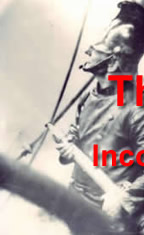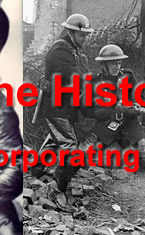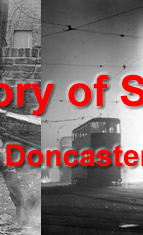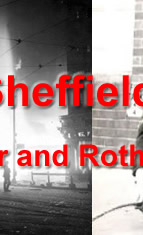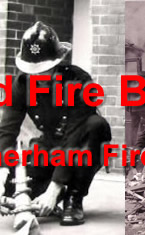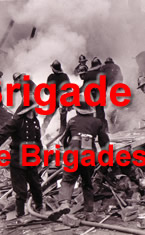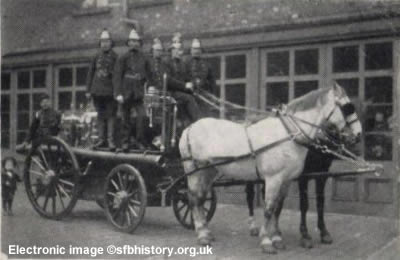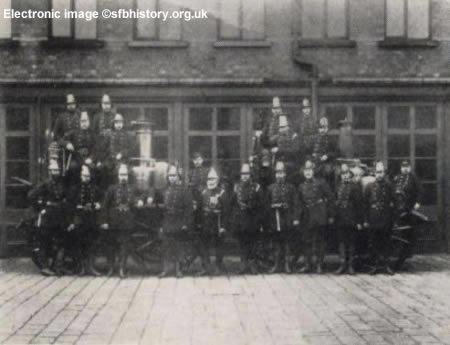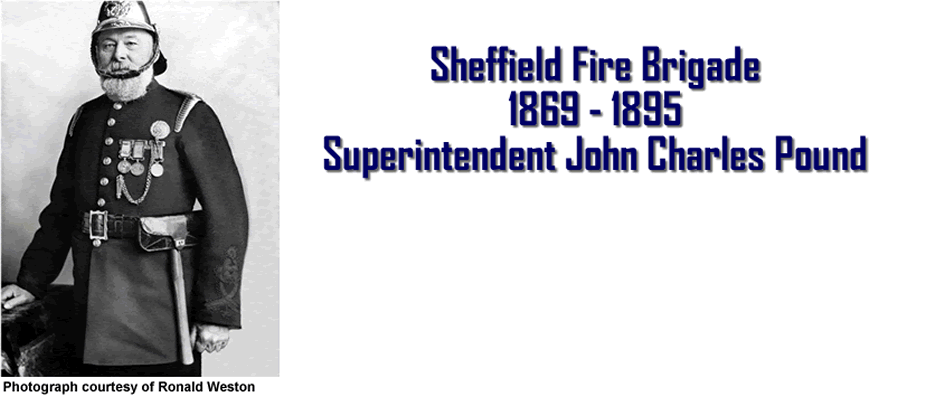
A New Fire Brigade is Born
In 1869 the Sheffield Town Council after much negotiation fully took over the responsibility for fire cover from the Insurance Brigades. The Council advertised for a Chief Fire Officer and by June of that year, thirty-seven applications had been received. From these six were selected for the short list:
| Thomas Wingfield | Metropolitan Fire Brigade |
| John Charles Pound | Nottingham Fire Brigade |
| Thomas Austin | Blackburn |
| Thomas J. Holmes | Royal Fire Brigade, Sheffield |
| E. Clements | Birkenhead |
| Henry Millward | Alliance Fire Office, Sheffield |
After they had been interviewed Mr. John Pound was appointed Superintendent of the Brigade as from the 15th July, 1869, at a salary of £100 per year, a house, coal and gas to he provided for his use. The decision of the Corporation to take over and run the Fire Brigade was brought to a head by the series of large fires between 1865 and 1869. Namely:The Surrey Theatre, West Bar, Mr. Burrells, Draper, Snig Hill, The Ragged Schools and Mudfords Rope Works, Exchange Street.
John Charles Pound the son of John Pound, a Shoemaker and Eliza Pound, was born in Sittingbourne, Kent in 1834. In 1858 he married Charlotte Daily of St James's, Middlesex, at St Bride's Parish Church, Fleet Street, London. At the time of their marriage John gave his occupation as Mariner.
In the 1861 Census John was recorded as living as a Fireman at the London Fire Engine Establishment Fire Station, at Waterloo Road, Lambeth, London, with his wife Charlotte, their 1 year old daughter Rosina, and 9 other Firemen and their families. On 9th September 1863, John and Charlotte baptised their daughter Rosina, born 6th February 1860, and their son John, born 13th July, 1863, at St Olav's Church, Tooley Street, Southwark, London. At that time they were recorded as living at the LFEE Fire station at Tooley Street. Whilst serving with LFEE he would have attended the Tooley Street fire.
The 1861 Tooley Street fire, which is often referred to as the greatest fire since the Great Fire of London, began on the afternoon of Saturday, 22 June 1861 at Cotton's Wharf, where many warehouses were situated. The buildings were filled with a huge array of goods, including jute, hemp, cotton, spices, tea, and coffee. The London Fire Engine Establishment were quick to get to the scene. By 6pm 14 fire engines, including a steam fire engine and a floating engine, were all fighting the blaze. By late evening the fire stretched from London Bridge to Custom House... the closely packed wharves were loaded with flammable goods. The fire spread quickly throughout the warehouses as the iron fire doors, which separated many of the storage rooms, had been left open. It is believed if they had been closed, as recommended by the Superintendent in charge of the London Fire Engine Establishment James Braidwood (previously the Firemaster of Edinburgh Fire Brigade), the fire may have burnt out, avoiding disaster. Following the Tooley Street fire the LFEE was reformed and the forerunner to the London Fire Brigade, the LCC Metropolitan Fire Brigade was formed. |
In 1869 the first Fire Station was in Norfolk Street opposite Milk Street. Mr. Pound had to form the new Brigade with 15 young constables and for eleven months living quarters were a problem as many of the men lived as far away as Spital Hill. When a fire occurred at night the men were called off their beats by whistle, and in the daytime Mr. Pound had to pick up any Constable he could find. The first fire attended by the new Brigade occurred on the 30th July, 1869 at a Cabinet Case Makers in Arundel Street. It took fifty minutes to obtain water because the fire occurred on the day before the Corporation required the Water Company to give a constant supply. Towards the latter end of the year the water was again turned off at night and so Mr. Pound insisted on a turncock being in attendance at the Fire Station to turn on the water in case of fire.
24th June, 1870 the Corporation took a lease of 5 houses in Holly Street, and the Firemen were installed in them, electric bells being connected to the houses, with. Superintendent Pound and his family living at the Fire Station, 114 Barkers Pool, and the appliances were moved to the new station, which was formerly the Weights and Measures Office. In 1874 Hose Carts and fire extinguishing apparatus were placed in each of the four Divisional Police Stations at Attercliffe, Broomhill, Highfields and Langsett Road. For four years after its inception the Brigade had to drag the engines by hand as it was not possible to obtain horses from the Angel Yard in Angel Street in any reasonable time.
In the 1871 Census Superintendent Pound, his wife Charlotte, and their 4 children were recorded as living at the Sheffield Fire Engine Station, No. 114 Barkers Pool, Sheffield. Also, it is recorded that Sheffield Fire Brigade had 5 Police Constables/Firemen and their families in accommodation close by on Holly Street. The Fire Brigade personnel listed were:
1871 Establishment Sheffield Fire Brigade Personnel
| 1 | Superintendent Fire Brigade |
| 5 | Police Constables/Firemen |
Open the abridged SFB 1871 Census (opens in anew page)
On the 20th September, 1873 a call was received to a fire at Fulwood and the Brigade had to wait 45 minutes for the horses. Before they were able to start an Alderman and several reporters came to the Station and the next day there was a long report in the press. After the next Council meeting two horses were purchased but there was no stabling for them and they had to stand in the yard of the Angel Inn at Moorhead; but eventually a 10 years', lease of a stable and coach house in Backfields was obtained.
On 4th January 1876 the Corporation purchased its first Steam Engine and on the 25th December, 1883 the Brigade removed to a new purpose built Fire Station with family accommodation at Rockingham Street, Sheffield which had been erected at a cost of £16,318.
In 1879 Sheffield Fire Brigade had 6 stations
Barkers Pool Fire Station |
Attercliffe Police Station |
Broomhill Police Station |
1 Horse Drawn Shand Mason Steam Engine |
1 Hose Cart |
1 Hose Cart |
Burngreave Rd Police Station |
Heeley Police Station |
Langsett Rd Police Station |
1 Hose Cart |
1 Hose Cart |
1 Hose Cart |
In the 1881 Census Superintendent Pound, his wife Charlotte, and their 7 children were recorded as living at the Court 72, House 2, Balm Green, Sheffield, furthermore, it is recorded that Sheffield Fire Brigade now had 10 Police Constables/Firemen, plus 1 Sergeant, and their families in accommodation on Holly Street. According to 1881 Census The Sheffield Fire Brigade personnel listed were:
It is worth noting that by now, over 50% of the Sheffield Police Firemen were from Nottinghamshire.Download the full 1881 SFB Census (Opens on a new page)
In 1889 the Establishment for Sheffield Fire Brigade was:
2 Horse Drawn Steam Engines - Shand Mason
2 Horse Drawn Manual Engines
2 Horse Drawn Hose Tenders
3 Escapes
30 Ladders
5 Hose Carts - 1 per Police Division with 30 men in each instructed in their use
22 Dedicated Fire Service personnel- 1 Superintendent, 1 Sergeant, 2 Engineers, 2 Coachmen, 16 Firemen, & 16 Auxiliary Firemen
Above information Supplied by Simon John Ryan
Prior to 1891 Rockingham Street Fire Station replaced Barkers Pool Fire Station. Rockingham Street Fire Station had a self-contained Superintendent's House and 21 Flats for officers, sergeants, firemen and their families.
1891 Establisment Sheffield Fire Brigade Personnel
| 1 | Superintendent Fire Brigade |
| 2 | Fire Brigade Engineers |
| 1 | Police Sergeant/Fireman |
| 18 | Police Constables/Firemen |
Download the abridged SFB 1891 Census (Opens on a new Page)
Sheffield becomes a City
The Town of Sheffield received its municipal charter in 1893, and officially became the City of Sheffield.
The second Steam Engine was purchased in 1884 and in 1894 another manual engine was replaced by a steamer. In 1895 five Kingston Fire Escapes were purchased and placed at each of the Divisional Police Stations. At this time the establishment of the Brigade was one Superintendent, one Sergeant, three engineers and 15 Firemen. The appliances consisted of three steam fire engines, one manual engine, two tenders, three telescopic fire escapes and one escape carried on a four wheeled tender and pulled by five horses. Each of the Divisional Police Stations had a fire escape and hose cart. |
 Photograph from Sheffield Fire Brigade - A Brief History Fire escape pitched at the front of Rockingham Street Fire Station |
(On 20th November 1953 a letter by Mrs. E. R. Haynes of Thornton Road, Sheffield, was printed in the "Star" This letter named all the people in the photograph on the right. Mrs. Haynes lived at West Bar Fire Station at the time that the photograph was taken and her father Sam Vause was one of the firemen.) The picture opposite shows Superintendent Pound and members of Brigade with two horse drawn steam pump fire engines, 1894. TOP ROW: (Left to Right): Fm Hoggard, Fm Vause, Fm Smith, Fm Dye SECOND ROW: Fm Hill, Fm Barrand, Fm Horne, Fm Boniface FRONT ROW: Fm Waller, Fm Ratcliffe, Fm Kenness, Fm Brownlee, Supt. Pound, Sgt. Crawford, Fm Pittaway, Fm Candlin, Fm Moore. The two engineers (wearing the pillbox caps) were Mr. Fletcher and Mr. Brookes.
|
|
Evening Telegraph and Star incorporating the Sheffield Daily Times, 9th June 1894:New Fire Brigade StationThe Fire Brigade Sub-committee's recommendation that a new station be built to accommodate an Inspector and 20 constables, and that in addition to the men’s dwellings it comprise an engine house, stable, and prison cells, having been approved, the sub-committee have endeavoured to find a suitable situation for the same, and beg to recommend that steps be taken to secure the plot of land at present vacant belonging to the Town Trustees at the junction of Westbar and Westbar Green. Messrs. Flockton and Gibbs are agents to the Trustees, and they say the site contains 649 yards, and it is to be let on lease for 99 years at 2s 6d. per yard. |
Injured:
On the 11th February 1895 Superintendent Pound was injured at the Park Club fire when he fell against a kerbstone whilst handling at jet. His injuries were at first thought to be bruising of the ribs, but later he suffered difficulty in breathing. He retired from the Fire Brigade shortly after in 1895, aged 62.
Following his retirement:
On the 18th March 1901 John’s wife of Charlotte, aged 61, passed away. The couple had been married for 43 years. Charlotte was buried at the Sheffield General Cemetery, Sheffield.
Later that month the 1901 Census records that 67 year-old John was living with his 24 year-old daughter Flora, his 18 year-old son Leonard, a Blacksmith’s Striker, and his 32 year-old cousin William Smith, a Groom, at 37 Onslow Road, Endcliffe, Sheffield.
The 1911 Census records that 77 year-old John was now living with his 32 year-old daughter Bertha, and his 28 year-old son Leonard, now a Post Office letter stamper, at 37 Onslow Road, Endcliffe, Sheffield.
John Charles Pound passed away on the 25th October 1918, leaving £615 8s 9d. His executors were his son Walter, and his daughter Bertha. He was buried at the Sheffield General Cemetery, Sheffield, alongside his wife Charlotte.
